Hai mai visto quel terrificante avviso "Non sicuro" nel tuo browser e ti sei preoccupato di cosa significhi per il tuo sito web? È una preoccupazione comune e termini tecnici come SSL e HTTPS possono rendere la ricerca di una soluzione opprimente.
Abbiamo guidato migliaia di utenti attraverso questo esatto processo e la buona notizia è che mettere in sicurezza il tuo sito è più facile di quanto pensi. È un semplice cambiamento che aumenta la fiducia dei visitatori e ti dà anche una piccola spinta nelle classifiche di ricerca.
In questa guida, ti accompagneremo nel passaggio del tuo sito WordPress da HTTP a HTTPS, passo dopo passo. Spiegheremo tutto in parole semplici, in modo che tu possa ottenere quell'icona del lucchetto sicuro accanto al nome del tuo dominio.
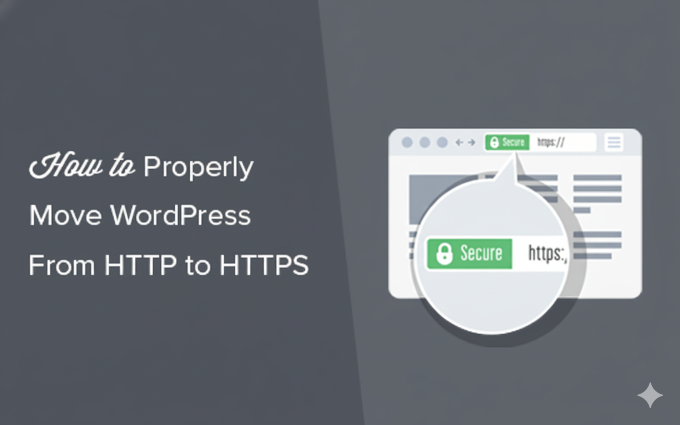
Riepilogo rapido: Come passare WordPress a HTTPS in 4 passaggi
- Ottieni un certificato SSL.
- Installa e attiva un plugin SSL come Really Simple SSL.
- Aggiorna le impostazioni del tuo sito per utilizzare HTTPS.
- Configura i reindirizzamenti e correggi eventuali errori di contenuto misto.
Ecco una rapida panoramica degli argomenti che tratteremo in questo articolo:
- Cos'è HTTPS?
- Perché hai bisogno di HTTPS e SSL?
- Requisiti per l'utilizzo di HTTPS/SSL su un sito WordPress
- Configurazione di WordPress per utilizzare SSL e HTTPS
- Metodo 1: Configura SSL/HTTPS in WordPress utilizzando un plugin
- Method 2: Set Up SSL/HTTPS in WordPress Manually
- Submit Your HTTPS Site to Google Search Console
- Domande frequenti sul passaggio a HTTPS
- Risorse aggiuntive per la sicurezza di WordPress
Cos'è HTTPS?
HTTPS (Hypertext Transfer Protocol Secure) è un metodo di crittografia che protegge la connessione tra il browser di un utente e il server del tuo sito web. Questa sicurezza aggiunta rende molto più difficile per gli hacker intercettare i dati trasferiti.
Per creare questa connessione sicura, è necessario un certificato SSL (Secure Sockets Layer). Sebbene "SSL" sia il termine comune usato dalle persone, la tecnologia moderna e più sicura utilizzata oggi dai siti si chiama TLS (Transport Layer Security).
Ogni sito web riceve un certificato SSL univoco per l'identificazione. Se un server tenta di utilizzare HTTPS senza un certificato valido o se il certificato non corrisponde, la maggior parte dei browser moderni avviserà gli utenti e consiglierà loro di non procedere.
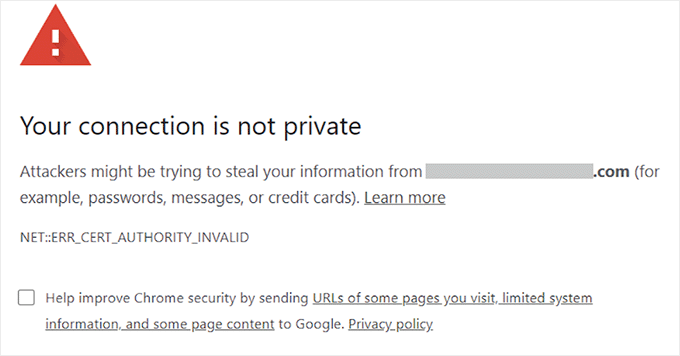
Perché hai bisogno di HTTPS e SSL?
Nel 2018, Google ha annunciato un'iniziativa per migliorare la sicurezza web esortando i proprietari di siti a passare da HTTP a HTTPS. Per supportare questa mossa, il loro browser Chrome ha iniziato a contrassegnare tutti i siti web senza un certificato SSL come "Non sicuro".
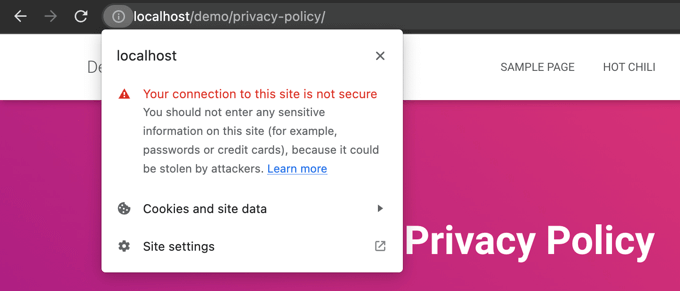
Questo avviso "Non sicuro" è particolarmente evidente quando qualcuno cerca di inserire informazioni, come compilare un modulo di contatto. Vedere questo avviso può lasciare un'impressione negativa e danneggiare la fiducia nella tua attività.
Ecco perché tutti i siti web devono passare a HTTPS e installare SSL. Ecco i principali vantaggi:
- Sicurezza migliorata: Cripta i dati scambiati tra i tuoi visitatori e il tuo server, proteggendo informazioni sensibili come credenziali di accesso e dati personali.
- Migliori classifiche SEO: Google offre un leggero vantaggio in termini di ranking ai siti web HTTPS sicuri.
- Costruisce la fiducia degli utenti: L'icona del lucchetto sicuro nella barra degli indirizzi del browser segnala istantaneamente ai visitatori che il tuo sito è autentico e sicuro, il che può migliorare i tassi di conversione.
- Richiesto per i pagamenti online: Se desideri accettare pagamenti online sul tuo sito eCommerce, allora SSL è richiesto da fornitori di pagamenti come Stripe, PayPal Pro e Authorize.net.
Ci assicuriamo che tutti i nostri siti utilizzino SSL, inclusi WPBeginner e le nostre aziende partner.
Requisiti per l'utilizzo di HTTPS/SSL su un sito WordPress
I requisiti per utilizzare SSL in WordPress non sono molto elevati. Tutto ciò che devi fare è acquistare un certificato SSL, e potresti già averlo gratuitamente.
Le migliori società di hosting WordPress offrono certificati SSL gratuiti per tutti i loro utenti:
Per maggiori dettagli, consulta la nostra guida su come ottenere un certificato SSL gratuito per il tuo sito WordPress.
Se la tua società di hosting non offre un certificato SSL gratuito, dovrai acquistarne uno.
Consigliamo Namecheap perché offre la migliore offerta SSL per certificati SSL regolari e wildcard.
Una volta acquistato un certificato SSL, dovrai chiedere al tuo provider di hosting di installarlo per te.
Configurazione di WordPress per utilizzare SSL e HTTPS
Dopo che il tuo host avrà abilitato un certificato SSL per il tuo nome di dominio, dovrai configurare WordPress per utilizzare i protocolli SSL e HTTPS sul tuo sito web.
Ti mostreremo due metodi per farlo, e potrai scegliere quello che meglio si adatta alle tue esigenze.
Metodo 1: Configura SSL/HTTPS in WordPress utilizzando un plugin
Questo metodo è più semplice ed è consigliato ai principianti.
Innanzitutto, devi installare e attivare il plugin Really Simple SSL. Per maggiori dettagli, consulta la nostra guida passo passo su come installare un plugin per WordPress.
Dopo l'attivazione, devi visitare la pagina Sicurezza. Il plugin rileverà automaticamente il tuo certificato SSL e ti mostrerà l'opzione "Attiva SSL".

Una volta attivato, il plugin si occuperà di tutto, inclusi gli errori di contenuto misto.
Ecco cosa fa il plugin dietro le quinte:
- Controlla la validità del certificato SSL
- Imposta WordPress per utilizzare https in tutti gli URL
- Imposta i reindirizzamenti da HTTP a HTTPS
- Cerca gli URL nei tuoi contenuti che vengono ancora caricati da origini HTTP insicure e tenta di correggerli.
Nota: Il plugin tenta di correggere gli errori di contenuto misto utilizzando una tecnica di output buffering. Questo può avere un impatto negativo sulle prestazioni perché sostituisce il contenuto del sito durante il caricamento della pagina. Questo impatto si nota solo al primo caricamento della pagina e dovrebbe essere minimo se si utilizza un plugin di caching.
Sebbene il plugin affermi che puoi mantenere SSL e disattivare in sicurezza il plugin, non è vero al 100%. Dovrai lasciare il plugin attivo in ogni momento perché disattivare il plugin riporterà gli errori di contenuto misto. Vedi la nostra recensione di Really Simple SSL per maggiori dettagli.
Metodo 2: Configura SSL/HTTPS in WordPress manualmente
Questo metodo richiede di risolvere i problemi manualmente e modificare i file di WordPress. Tuttavia, è una soluzione permanente e ottimizzata per le prestazioni, ed è il metodo che utilizziamo su WPBeginner.
Se trovi questo metodo difficile, dovresti assumere uno sviluppatore WordPress o utilizzare il primo metodo.
Come parte di questo metodo, potrebbe essere necessario modificare i file del tema e del codice. Se non l'hai mai fatto prima, consulta la nostra guida su come copiare e incollare snippet di codice in WordPress.
Innanzitutto, dovresti visitare la pagina Impostazioni » Generali. Da qui, aggiorna i campi Indirizzo WordPress e URL del sito sostituendo http con https.
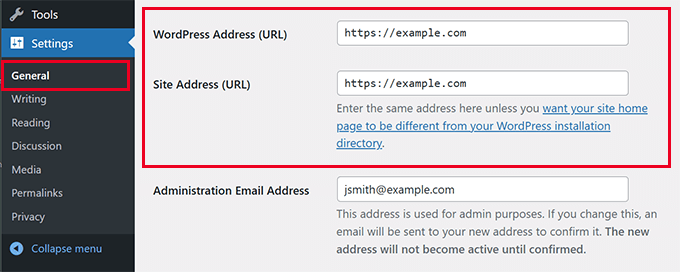
Quindi, fai clic sul pulsante 'Salva modifiche' per memorizzare le nuove impostazioni.
Una volta salvate le impostazioni, WordPress ti disconnetterà e ti verrà chiesto di accedere nuovamente.
Successivamente, configura i reindirizzamenti di WordPress da HTTP a HTTPS aggiungendo il seguente codice al file .htaccess. Questo codice è per server Apache:
Se sei su un server NGINX, aggiungerai il seguente codice per reindirizzare da HTTP a HTTPS nel file di configurazione:
Non dimenticare di sostituire example.com con il nome del tuo dominio.
Seguendo questi passaggi, eviterai l'errore di WordPress HTTPS non funzionante perché WordPress caricherà ora l'intero sito web utilizzando HTTPS.
Per forzare SSL e HTTPS nell'area di amministrazione di WordPress o nelle pagine di accesso, è necessario configurare SSL nel file wp-config.php.
Aggiungi il seguente codice sopra la riga “Fine!” nel file wp-config.php:
define('FORCE_SSL_ADMIN', true);
Questa costante funge da meccanismo di sicurezza. Garantisce che la pagina di accesso e la dashboard di WordPress siano sempre crittografate, aggiungendo un ulteriore livello di sicurezza per l'amministratore del sito. Funziona anche su reti WordPress multisito.
Una volta fatto ciò, il sito web è completamente configurato per utilizzare SSL / HTTPS, ma potresti ancora riscontrare errori di contenuto misto.
Correzione degli errori di contenuto misto
Gli errori di contenuto misto sono causati quando alcuni contenuti (come immagini, script o fogli di stile) vengono ancora caricati tramite il protocollo HTTP insicuro anziché HTTPS.
Pensala come avere una porta d'ingresso sicura e blindata (HTTPS) ma lasciare una finestra sbloccata (una risorsa HTTP). Quell'unica finestra sbloccata rende l'intera casa vulnerabile.
Quando ciò accade, non vedrai l'icona del lucchetto sicuro nella barra degli indirizzi del tuo sito web.

Puoi scoprire quale contenuto viene servito tramite un protocollo insicuro utilizzando lo strumento Ispeziona elemento del tuo browser.
L'errore di contenuto misto verrà visualizzato come un avviso nella console, con dettagli per ogni elemento.
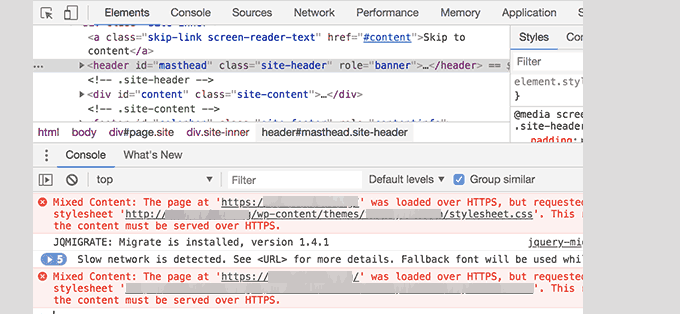
Noterai che la maggior parte degli URL sono immagini, iframe e gallerie di immagini, mentre alcuni sono script e fogli di stile caricati da plugin e temi di WordPress.
Correzione del contenuto misto nel database di WordPress
La maggior parte degli URL errati saranno per immagini, file, embed e altri dati archiviati nel database di WordPress. Correggiamoli prima.
Devi trovare tutte le menzioni del tuo vecchio URL del sito web nel database che iniziano con HTTP e sostituirle con il tuo nuovo URL del sito web che inizia con HTTPS.
Puoi farlo facilmente installando e attivando il plugin Cerca e sostituisci tutto.
Dopo l'attivazione, visita la pagina Strumenti » WP Search & Replace. Devi aggiungere l'URL del tuo sito web con http nel campo 'Cerca' e il tuo URL con https nel campo 'Sostituisci'.
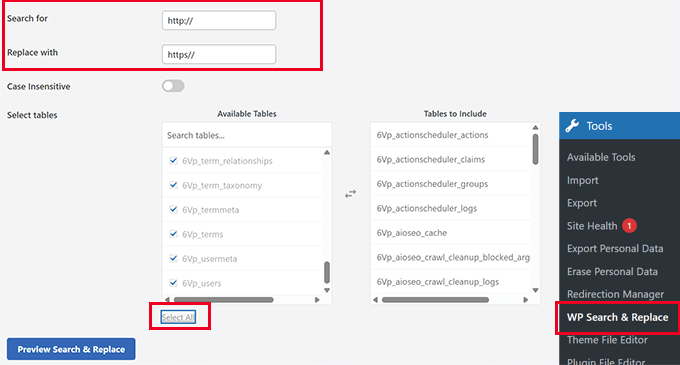
Quindi, seleziona tutte le tabelle del database per eseguire un controllo approfondito e fai clic sul pulsante 'Sostituisci tutto'. Il plugin aggiornerà ora tutti i vecchi URL nel database.
Correzione degli errori di contenuto misto causati dal tema di WordPress
Qualsiasi tema WordPress decente che segua gli standard di codifica di WordPress non causerà questo problema. Tuttavia, alcuni potrebbero ancora codificare in modo fisso URL non sicuri.
Innanzitutto, dovrai utilizzare lo strumento Ispeziona del browser per trovare le risorse e da dove vengono caricate. Dopodiché, dovrai trovarle nei file del tuo tema WordPress e sostituire http con https.
Questo sarà un po' difficile per la maggior parte dei principianti, poiché potresti non essere in grado di vedere quali file del tema contengono questi URL.
Risolvere gli errori di contenuto misto causati dai plugin
Alcune risorse di contenuto misto verranno caricate da plugin WordPress. Qualsiasi plugin WordPress che segua gli standard di codifica di WordPress non causerà errori di contenuto misto.
Sconsiglio vivamente di modificare i file dei plugin di WordPress. Invece, ti consiglio di contattare l'autore del plugin e informarlo. Se non risponde o non è in grado di risolverlo, allora cercherei un'alternativa adatta.
Nota: Se, per qualche motivo, continui a riscontrare un errore di contenuto misto, ti consigliamo di utilizzare temporaneamente il plugin Really Simple SSL in modo che i tuoi utenti non vengano influenzati mentre risolvi il problema su un sito di staging o assumi uno sviluppatore.
Invia il tuo sito HTTPS a Google Search Console
I motori di ricerca come Google trattano https e http come due siti web diversi. Per evitare problemi di SEO, dovrai informare Google che il tuo sito web si è spostato.
Per farlo, devi solo andare al tuo account Google Search Console e fare clic sul pulsante 'Aggiungi proprietà'.
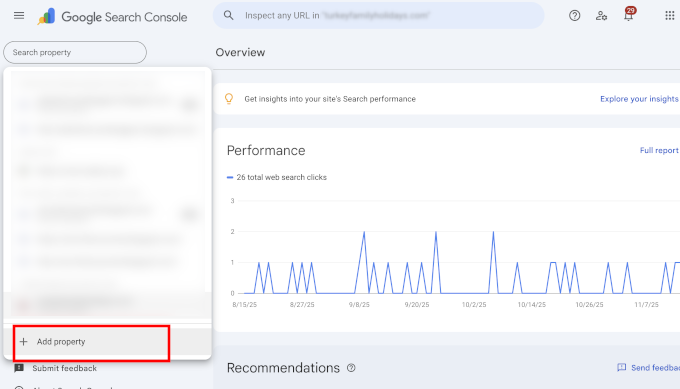
Questo aprirà un popup in cui dovrai aggiungere l'indirizzo HTTPS del tuo sito web.
Google offre diversi modi per verificare il tuo sito, ma raccomandiamo il metodo del prefisso URL perché è più flessibile.
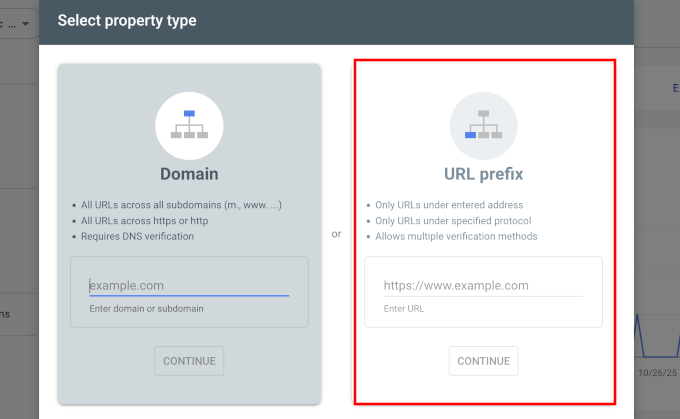
Dopodiché, Google ti chiederà di verificare la proprietà del tuo sito web.
Ci sono diversi modi per farlo, ma raccomandiamo di utilizzare il metodo del tag HTML. Riceverai uno snippet di codice HTML da aggiungere al tuo sito WordPress.
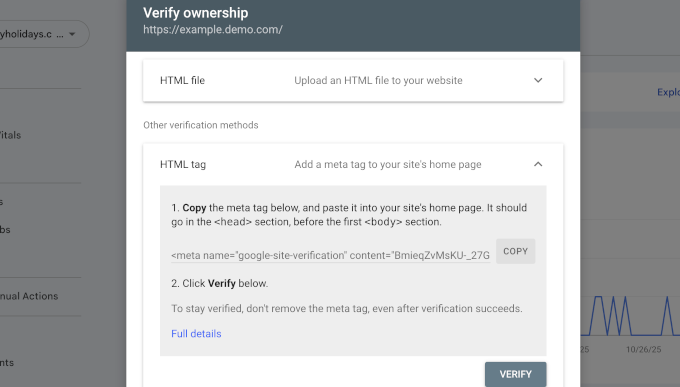
Aggiungi il codice di verifica di Search Console utilizzando All in One SEO
Innanzitutto, installa e attiva il plugin All in One SEO per WordPress. Per maggiori dettagli, consulta il nostro tutorial su come installare un plugin WordPress.
Suggerimento dell'esperto: Noi di WPBeginner utilizziamo All in One SEO su tutti i nostri siti web. La funzionalità di verifica degli Strumenti per webmaster ci fa risparmiare molto tempo, poiché possiamo semplicemente incollare il codice e AIOSEO lo aggiunge automaticamente nel punto corretto dell'intestazione del nostro sito.
Dopo l'attivazione, vai alla pagina All in One SEO » Impostazioni generali e fai clic sulla scheda Strumenti per webmaster. Da lì, fai clic su Google Search Console.
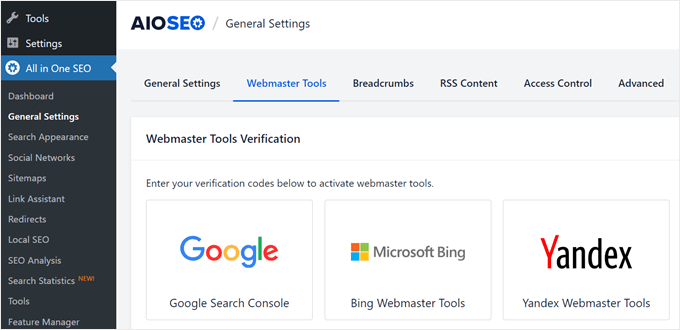
Qui, devi aggiungere il codice di verifica che hai copiato in precedenza dal sito web di Google Search Console. Non dimenticare di fare clic sul pulsante 'Salva modifiche' per memorizzare le tue impostazioni.
Successivamente, torna alla scheda Google Search Console e fai clic sul pulsante ‘Verifica’. Una volta verificato il tuo sito, Google inizierà a mostrare i tuoi report di Search Console.
Devi anche assicurarti che vengano aggiunte sia la versione https che quella http alla tua Search Console.
Questo indica a Google che desideri che la versione https del tuo sito web venga trattata come la versione principale. In combinazione con i reindirizzamenti 301 che hai impostato in precedenza, Google trasferirà i tuoi ranking di ricerca alla versione https del tuo sito web.
Domande frequenti sul passaggio a HTTPS
Quanto costa un certificato SSL?
Un certificato SSL può essere gratuito. La maggior parte delle principali società di hosting WordPress offre certificati SSL gratuiti a tutti i propri clienti tramite Let’s Encrypt. Se il tuo host non ne offre uno gratuito, puoi acquistarne uno da un provider come Namecheap per una piccola tariffa annuale.
Qual è la differenza tra SSL e HTTPS?
SSL (Secure Sockets Layer) è la tecnologia che crittografa i dati. HTTPS (Hypertext Transfer Protocol Secure) è il risultato dell’utilizzo di tale tecnologia SSL. Quando un sito web dispone di un certificato SSL valido, il suo URL inizia con https:// e un’icona a forma di lucchetto appare nel browser, mostrando che la connessione è sicura.
Cosa succede se non uso HTTPS?
Se non utilizzi HTTPS, i browser moderni come Google Chrome visualizzeranno un avviso “Non sicuro” ai tuoi visitatori. Ciò può erodere la fiducia, danneggiare la reputazione del tuo marchio e farti perdere potenziali clienti. Inoltre, non avere HTTPS può influire negativamente sui tuoi ranking nei motori di ricerca.
Risorse aggiuntive per la sicurezza di WordPress
Di seguito sono riportate alcune risorse aggiuntive che possono aiutarti a risolvere problemi comuni di WordPress e a saperne di più sulla sicurezza del sito web:
- Come risolvere i problemi comuni di SSL in WordPress (Guida per principianti)
- Errori più comuni di WordPress e come risolverli
- Come risolvere l'errore di connessione sicura in WordPress
Speriamo che questo articolo ti abbia aiutato ad aggiungere HTTPS e SSL in WordPress. Potresti anche voler consultare la nostra guida definitiva alla sicurezza di WordPress con istruzioni passo passo per mantenere sicuro il tuo sito WordPress o la nostra guida su come rinnovare il tuo certificato SSL.
Se ti è piaciuto questo articolo, iscriviti al nostro canale YouTube per tutorial video su WordPress. Puoi anche trovarci su Twitter e Facebook.





Jiří Vaněk
Il plugin Search and Replace Everything è letteralmente un miracolo. Prima sistemavo tutto direttamente nel database, ma ora posso facilmente cambiare http in https usando questo plugin. In precedenza, gestivo i problemi di contenuto misto con il plugin Really Simple SSL. Era un piccolo plugin, ma è cambiato significativamente ed è cresciuto molto (ora è più un plugin di sicurezza che una soluzione per contenuti misti, credo). Sfortunatamente, questo ha iniziato a rallentare i miei siti web. Ecco perché ho deciso di sistemare tutto nel database usando Search and Replace, e sono completamente soddisfatto. Gli URL nel database sono impostati correttamente su https e non ho più bisogno di alcun plugin per risolvere i contenuti misti. È davvero un plugin indispensabile perché fa esattamente ciò per cui è stato progettato, perfettamente. Lo consiglio vivamente a chiunque abbia un problema simile.
kzain
Questo è un ottimo punto! Un sito web non sicuro, specialmente un sito di e-commerce che raccoglie pagamenti, può creare un'esperienza negativa per i visitatori. È fondamentale avere un sito web HTTPS per creare fiducia e garantire la sicurezza. Molti provider di hosting, come Bluehost, offrono certificati SSL gratuiti e persino nomi di dominio gratuiti per il primo anno. Con Bluehost, non è nemmeno necessario installare manualmente il certificato SSL: è un gioco da ragazzi! Grazie per aver condiviso queste importanti informazioni. grazie per aver condiviso questo post con noi
Mrteesurez
Questo è davvero fantastico.
Niente è peggio di un visitatore che vede un sito web insicuro, specialmente un e-commerce che raccoglie pagamenti online dagli utenti, questa è decisamente una brutta esperienza.
Ecco perché è sempre consigliabile avere un sito web https. Scegliere uno degli hosting che hai elencato come Bluehost e altri offre SSL gratuito e dominio gratuito per il primo anno.
Con Bluehost, non è necessario installare manualmente il certificato SSL sul tuo sito web.
Grazie, lo condivido.
Moinuddin Waheed
uno dei miei clienti ha recentemente acquistato un hosting condiviso da GoDaddy e poi ha chiesto di realizzare il suo sito web.
Ho iniziato a crearne uno e mi sono reso conto che non dispone di un'installazione SSL integrata con un clic come quella di Hostinger, Bluehost e altri provider di hosting menzionati sopra.
Il valore di un buon hosting è diventato evidente quando ho dovuto affrontare il laborioso processo di installazione del certificato SSL.
È molto consigliabile scegliere un buon servizio di hosting.
Moinuddin Waheed
Avere https per i siti web è un must per garantire la fiducia dei visitatori sul sito web.
Sono solo curioso se abbiamo già abilitato SSL per i nostri siti web, è necessario cambiare ovunque da http a https?
O lo prenderà automaticamente.
Supporto WPBeginner
Dipenderebbe da come hai abilitato SSL e dal tuo provider di hosting, poiché alcuni aggiorneranno automaticamente il tuo sito a https mentre altri no. Dovresti controllare il tuo sito per vedere se è stato aggiornato e, in caso contrario, dovrai aggiornare manualmente l'indirizzo del sito.
Amministratore
Jiří Vaněk
Di solito è necessario modificare manualmente tutto in https o utilizzare il plugin Really Simple SSL. Se parte del sito sarà http e parte sarà https, si parla di contenuti misti e si finirà con errori e problemi.
GRAZIE DIO GIOVANNI
Se sei un principiante e non sai molto di codifica, ti consiglio di utilizzare il primo metodo.
Modificare il codice di WordPress è molto rischioso, soprattutto per chi non sa codificare. Dopotutto, il plugin è più facile da usare e ha anche una versione gratuita.
Moinuddin Waheed
La maggior parte dei provider di hosting oggi offre un certificato SSL gratuito al tuo sito con un'installazione in un clic, come hai menzionato.
Avere un certificato SSL installato sul sito web è di estrema importanza in quanto dà un senso di sicurezza ai visitatori e questi possono essere certi che tutto ciò che fanno su un sito web con certificato SSL installato è sicuro.
Grazie per aver fornito una descrizione dettagliata di http e https.
Supporto WPBeginner
You’re welcome
Amministratore
Nimdaqiu
Non mi sento più un principiante ora. Grazie per questo articolo splendidamente dettagliato.
Supporto WPBeginner
Siamo lieti di aver potuto semplificare il processo!
Amministratore
Andrew Meador
Ho seguito il Metodo 2. L'unica cosa che ho modificato è stato l'uso del metodo di reindirizzamento di WordPress. Il mio provider web ha uno strumento che crea un reindirizzamento (per hosting su Windows Server) che aggiunge regole di reindirizzamento nel web.config – consentendo al reindirizzamento a HTTPS di avvenire a livello di web server anziché a livello di WordPress. Funziona bene ed è 1 livello di astrazione superiore. Grazie!
Supporto WPBeginner
Thanks for sharing, not all hosting providers offer that but glad your host was able to help
Amministratore
Clinton Waller
Grazie mille per questo eccellente tutorial.
Ho recentemente installato un certificato SSL e temevo il passaggio con WordPress e Google. Non dico che non ci sia stato alcun problema, ma le tue istruzioni passo passo mi hanno aiutato enormemente!
Ho apprezzato molto anche il codice .htaccess, è semplicemente perfetto. Temevo che Google indicizzasse sia le varianti http insicure che quelle https sicure del vecchio e nuovo sito web, penalizzandomi nel ranking, ma questo trucco evita completamente di servire contenuti legacy http insicuri — un vero vantaggio!
William
Ho un mix di domini (tutti HTTPS) sul mio sito WordPress. Questo plugin può scorrere il mio sito e impostarli tutti sul mio dominio attuale?
Supporto WPBeginner
Dovresti verificare con il tuo provider di hosting, poiché alcuni dispongono di strumenti per quello che sembra tu voglia fare.
Amministratore
Lungo
Non ci sono semplicemente 'Indirizzo WordPress' e 'Indirizzo Sito' nelle 'Impostazioni Generali'.
Ora uso WordPress multisite, un sito è https e un altro è http. Questa installazione di WordPress è nuova, ho già impostato https nella mia precedente installazione di WordPress sul mio SiteGround.
Supporto WPBeginner
Dovresti andare nell'amministrazione di rete per modificare gli URL dei tuoi siti su un'installazione multisite.
Amministratore
NIKHIL
Sto usando il primo metodo, quindi c'è bisogno di apportare modifiche all'indirizzo e all'URL di WordPress e del sito??
Supporto WPBeginner
Finché non ci saranno intoppi con il plugin, non dovresti aver bisogno di modificare il tuo indirizzo e URL, poiché il plugin se ne occuperebbe per te.
Amministratore
Stein
Ho seguito i passaggi del metodo 2, ma una volta raggiunto il passaggio "Una volta salvate le impostazioni, WordPress ti disconnetterà e ti verrà chiesto di effettuare nuovamente l'accesso." invece di disconnettermi semplicemente, ora dice anche che "questo sito non è disponibile" quando provo ad accedere nuovamente a wp-admin, rendendo impossibili i passaggi successivi.
Quindi come posso accedere al sito wp-admin dopo aver cambiato l'URL?
Supporto WPBeginner
Per quell'errore specifico, dovresti seguire i passaggi per la risoluzione dei problemi nel nostro articolo qui sotto:
https://www.wpbeginner.com/beginners-guide/beginners-guide-to-troubleshooting-wordpress-errors-step-by-step/
Amministratore
Jithin
dopo aver aggiunto questa home page sta reindirizzando ma i post non reindirizzano a https.
http e https .. entrambi funzionano .. per favore aiutatemi.
Supporto WPBeginner
Se dovessi riscontrare quel problema, dovresti contattare il tuo provider di hosting per assicurarti che non abbiano impostato alcun reindirizzamento.
Amministratore
shantun
Aiuta molto, grazie
Supporto WPBeginner
Glad our guide was helpful
Amministratore
RichPat
Grazie per le istruzioni per l'aggiornamento SSL.
Usare Really Simple SSL con il mio certificato fornito dall'hosting è stato un processo di aggiornamento molto semplice
Supporto WPBeginner
Glad our guide was helpful
Amministratore
Michael
Grazie per il tuo prezioso contenuto. Ti chiedo, se posso usare il plugin Really simple SSL che è più facile, perché dovrei farlo manualmente.
Supporto WPBeginner
Sarebbe principalmente per preferenza personale, non dovrebbe esserci una grande differenza tra l'uso del plugin o la modifica manuale.
Amministratore
Jithin
Grazie per la guida.
Sto per installare un WordPress nuovo di zecca su Hostgator. Devo fare qualcosa di diverso per HTTPS? o seguire la guida dopo l'installazione?
Supporto WPBeginner
Puoi seguire la nostra guida dopo aver installato il tuo sito per abilitare https.
Amministratore
nick Devine
Ciao, sono andato nelle impostazioni e ho cambiato http in https e ora sono completamente bloccato fuori da WordPress. Hai una soluzione per questo dato che è il sito web di un cliente e sono preoccupato di aver perso tutto completamente. Nick
Supporto WPBeginner
Dovresti abilitare un certificato SSL per il sito o contattare il tuo provider di hosting per assisterti nel ripristino degli URL a HTTP
Amministratore
Oleksandr Piddubnyy
Innanzitutto, devi visitare la pagina Impostazioni » Generali. Da qui devi aggiornare i campi dell'indirizzo di WordPress e del sito sostituendo http con https.
MA! Dopo di che la mia pagina è totalmente disabilitata! Non posso fare il backup. Non posso nemmeno accedere al pannello di amministrazione. E non so cosa stia succedendo. Cosa dovrei fare? Hai qualche idea?
Supporto WPBeginner
Sembra che tu non abbia abilitato un certificato SSL sul tuo sito prima di cambiare l'indirizzo. Dovresti contattare il tuo provider di hosting per abilitare un certificato SSL per il tuo sito o chiedere loro di reimpostare i tuoi URL su HTTP
Amministratore
osama khan
Buongiorno, grazie per la guida. Ho installato un WordPress nuovo di zecca su un VPS con un indirizzo IP. Ora, voglio cambiarlo con un nome di dominio – Devo fare qualcosa di diverso per l'HTTPS:// ?
Supporto WPBeginner
Dovresti verificare con il tuo provider di hosting come sono configurati i loro server per lo scambio con il dominio.
Amministratore
Araceli
Ciao! Sembra che, dopo aver seguito i passaggi attraverso "Risolvere gli errori di contenuto misto nel tema WordPress", le mie immagini stiano causando problemi di contenuto misto. L'errore che ricevo è "Questo contenuto dovrebbe essere servito anche tramite HTTPS". Come posso risolvere questo problema?
Supporto WPBeginner
Per risolvere il contenuto misto, dovresti consultare il nostro articolo qui sotto:
https://www.wpbeginner.com/plugins/how-to-fix-the-mixed-content-error-in-wordpress-step-by-step/
Amministratore
Araceli
Lo farò... grazie!
Putri
andrebbe bene se cambiassi l'indirizzo del sito e l'indirizzo del sito in https ma non facessi il resto del processo manuale, per poi installare il plugin?
Supporto WPBeginner
Ti consigliamo, se hai intenzione di utilizzare il plugin, di iniziare con il metodo del plugin per evitare intoppi durante il processo.
Amministratore
Amar
Salve Signore,
Ho un sito WordPress in esecuzione su WordPress 3.5.1. Posso usare il plugin Really Simple SSL per questo? Il plugin dice che richiede WordPress 4.6 e versioni successive.
Per favore, suggeriscimi come posso fare
Grazie
Supporto WPBeginner
Per aggiornare il tuo sito WordPress, dovresti seguire la nostra guida qui sotto:
https://www.wpbeginner.com/beginners-guide/ultimate-guide-to-upgrade-wordpress-for-beginners-infograph/
Amministratore
Shawn
Non riesco ad accedere all'URL di accesso all'amministratore dopo aver aggiornato gli URL del sito, continua a reindirizzare a https ma ricevo un errore "Questo sito non può essere raggiunto". Ho anche provato ad aggiornare il file .htaccess ma senza successo. Anche il sito web originale non viene reindirizzato a https.
Hai qualche idea su cosa potrei star perdendo?
Supporto WPBeginner
Dovresti prima contattare il tuo provider di hosting affinché dia un'occhiata e si assicuri che il tuo certificato SSL non abbia problemi.
Amministratore
Lola
Grazie!
Grazie!
GRAZIE!!!
Supporto WPBeginner
You’re welcome
Amministratore
Kevin
Grazie, quel plugin Better Search and Replace ha risolto!
Supporto WPBeginner
You’re welcome, glad our recommendation was helpful
Amministratore
daniel
dove esattamente dovrei inserire il codice nel file .htaccess?
Supporto WPBeginner
The normal location would be beneath the current code in your htaccess file
Amministratore
Jessica
Le pagine interne e le pagine dei post si aprono ancora con http, il che influenzerà i motori di ricerca. Cosa devo fare ora?
Supporto WPBeginner
Probabilmente dovrai cancellare tutta la cache del tuo sito e potresti voler verificare con il tuo provider di hosting che il certificato SSL sia stato applicato correttamente.
Amministratore
Leos
Perché aggiungere define(‘FORCE_SSL_ADMIN’, true) al file wp-config se la regola di reindirizzamento .htaccess fa già il lavoro?
Quando ho aggiunto la riga al file wp-config ho ottenuto un errore di sintassi subito dopo e non è stato possibile accedere all'area admin.
Supporto WPBeginner
FORCE_SSL_ADMIN serve per la tua area admin per assicurarsi che utilizzi HTTPS. Dovresti assicurarti di aver copiato l'intero codice correttamente. Se ti fosse mancato il punto e virgola, avresti ottenuto un errore di sintassi.
Amministratore
rohan
Salve,
Grazie per la guida dettagliata. Dopo aver effettuato il passaggio da HTTP a HTTPS, ho aggiunto la nuova proprietà a Google Search Console.
Devo inviare nuovamente anche le sitemap nella versione HTTPS in GSC?
Beginner query.
Supporto WPBeginner
Per sicurezza, sì, dovresti farlo.
Amministratore
Celena
Grazie! Molto utile!
Supporto WPBeginner
You’re welcome
Amministratore
Phil
Better Search & replace è la versione 1.3.3 e non è stato aggiornato per un anno e non è testato sulla versione attuale di wordpress. È compatibile solo fino alla 5.2.6.
È sicuro da usare, o puoi raccomandare un'alternativa per favore?
Supporto WPBeginner
Per questi avvisi, dovresti dare un'occhiata alla nostra guida qui sotto.
https://www.wpbeginner.com/opinion/should-you-install-plugins-not-tested-with-your-wordpress-version/
Amministratore
RomRom
La soluzione 2 non funzionava per me, il sito web sarebbe stato non disponibile.
Dopo alcuni tentativi, ho notato che il mio provider di hosting fornisce già un'opzione per forzare https. Attivala e il gioco è fatto.
Supporto WPBeginner
Glad you were able to find a solution that worked for you
Amministratore
Feranmi
E se il mio provider di hosting non supporta un certificato SSL gratuito, il plugin funzionerà comunque o come posso ottenerlo gratuitamente?
Supporto WPBeginner
Se il tuo host attuale non offre SSL gratuito, dovresti contattarli per sapere quali opzioni sono disponibili.
Amministratore